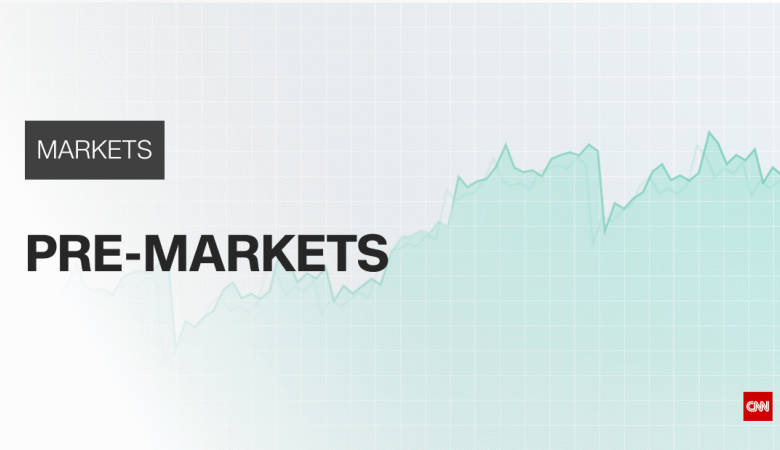Premarket Stocks: Key Moves by Shopify, Peloton, and More

Premarket stocks are drawing significant attention in the financial news today, highlighting noteworthy movements before the official market opening. Investors are keeping a close eye on stocks like Shopify, AppLovin, and Tapestry as they reveal pivotal insights into market sentiment and trending stocks. In premarket trading, these companies show fluctuations that can provide clues about stock market moves for the day ahead. As we delve into the latest investment updates, it’s crucial to understand how these premarket shifts impact potential trading strategies. With volatility in premarket stocks, navigating the investment landscape requires acute awareness of these early indicators.
Early stock trading, commonly referred to as premarket trading, serves as a vital window into the potential direction of the stock market before it officially opens. This phenomenon captures the movements of various equities, drawing interest from investors seeking insights into future performance. As companies like Shopify and AppLovin report their earnings, their early stock movements can reveal sentiments that might sway the broader market. Moreover, these fluctuations in early trading provide crucial investment updates that help traders make informed decisions. Understanding the implications of these early trading shifts is essential for those looking to capitalize on emerging trends in the financial world.
Significant Moves in Premarket Stocks
The premarket trading session has witnessed notable shifts among major stocks, with certain companies capturing investor attention due to surprising earnings reports and forecasts. For instance, Shopify saw a significant drop in its shares by 8.7%, even while its first-quarter revenue exceeded expectations, highlighting the volatile nature of investor sentiment in response to broader operational guidance. This reaction reflects a theme seen in premarket stocks, where positive financial outcomes do not always translate to stock gains, especially if anticipated future performance draws skepticism from the market.
On the contrary, AppLovin’s shares soared by 14.7% as it announced earnings that surpassed expectations alongside the divestiture of its mobile gaming unit. Such contrasting movements illustrate the dynamics of premarket trading; in one instance, stocks can plummet despite strong quarterly results due to caution about future earnings, while in another, shares can skyrocket based on solid performance and strategic corporate decisions. Investors in the stock market must remain vigilant and receptive to the fluctuating narratives that influence these investments.
Top Trending Stocks in Premarket Trading
Amidst the ebb and flow of the stock market, certain stocks are trending heavily in premarket trading based on their recent performances and financial disclosures. Companies like Tapestry have emerged as strong players with their shares gaining 8.4% after exceeding analyst earnings forecasts. This highlights a growing interest in affordable luxury brands, indicating market shifts towards consumer discretionary spending amid changing economic conditions.
Conversely, the semiconductor industry is also seeing substantial activity, with shares of Broadcom and AMD rising due to anticipated regulatory changes affecting AI chip manufacturing. Broadly, investor sentiment is tilting towards stocks involved in tech advancements as they align with current trends in market movements. Tracking these trending stocks can provide valuable insights for investment updates, allowing investors to make informed decisions as the trading day unfolds.
Financial News Impacting Premarket Stocks
The landscape of financial news is integral in shaping market reactions during premarket hours. Disturbances in expected earnings, corporate strategies, or macroeconomic indicators can lead to dramatic stock price swings. For example, news of President Trump considering a new Medicare pricing plan sparked declines in pharmaceutical stocks like Amgen and Eli Lilly, demonstrating how political developments can directly affect investor confidence and company valuations.
Additionally, updates regarding company earnings can dramatically alter investor sentiment. Peloton experienced a decline of 3.3% due to a greater than anticipated loss in its first quarter, indicating that perceived performance misalignments with investor expectations can have immediate and significant impacts on premarket stocks. Keeping abreast of such financial news is crucial for investors looking to navigate the complexities of the stock market effectively.
The Role of Earnings Reports in Stock Market Moves
Earnings reports serve as critical indicators for the performance and future potential of stocks, especially during premarket trading sessions. Companies like Tapestry and AppLovin exemplified this phenomenon with their earnings results prompting significant movements—Tapestry’s stock surged post-earnings, reinforcing the company’s position in the affordable luxury sector, while AppLovin’s performance bolstered by strong earnings highlighted the importance of AI-driven sectors.
However, the market reaction can often defy logic, as seen with Shopify, whose solid revenue results did not translate into positive stock movement. Investors are often focused on future guidance, which can lead to fluctuations in stock prices regardless of current earnings. This underscores the necessity for traders to analyze both past and projected financial health within the context of broader market trends when assessing stock market moves.
Understanding Volatility in Premarket Trading
Volatility in premarket trading is a crucial aspect for investors to consider, as it often foreshadows broader market trends for the trading day. The reactions to earnings releases, such as those from companies like Skyworks Solutions and Cleveland-Cliffs, illustrate how early morning trading can be fraught with unpredictability. Skyworks saw a decline in its stock despite a positive earnings report, emphasizing the importance of market expectations versus actual performance outcomes.
Such volatility can serve as both risk and opportunity for traders. Premarket movers reflect shifts in sentiment that can create entry points for investors looking to capitalize on potential rebounds or corrections throughout the day. Therefore, understanding the underlying factors driving movements in premarket stocks is essential for making informed trading decisions.
Investment Updates from Key Market Players
Investment updates from key players often dictate market sentiment and movements during premarket trading. Companies like Fortinet and Warner Bros. Discovery received attention due to their recent earnings reports. Fortinet, while missing market guidance, still saw ample trading activity, pointing to investors’ weighing long-term growth against immediate earnings results. Similarly, Warner Bros. Discovery’s disappointing quarterly loss prompted analysts to reassess their positions, demonstrating how investment news feeds into broader stock performance narratives.
These updates not only affect individual stocks but can have ripple effects across related sectors. As trends emerge from these reports, investors can gain insights into potential market shifts and align their strategies accordingly. Being attuned to investment updates allows traders in the stock market to stay ahead of developing stories that can influence premarket stocks and overall trading activity.
Analyzing Sector Performance in Premarket Trading
Sector analysis in premarket trading reveals distinct patterns and trends that can influence stock market trajectories. The technology sector, particularly semiconductor stocks, has shown resilience, with companies like Broadcom and AMD gaining traction from favorable regulatory news. Investors keep a keen eye on such movements, recognizing the impact that sectoral performances can have on overall market conditions.
In contrast, the pharmaceutical sector faced headwinds due to potential changes in pricing policies, causing shares of major companies like Amgen and Abbvie to fall. This highlights the interaction between sector-specific news and broader market sentiment, where shifts in regulations can lead to quick adjustments in stock prices. Analyzing sector performance thus becomes essential for stock market participants aiming for strategic investment decisions amid rapidly changing market dynamics.
Market Sentiment and Its Effect on Stock Prices
Market sentiment plays a pivotal role in determining stock prices, especially during the premarket trading phase. Factors such as investor perception, external news, and economic indicators all converge to shape the mood surrounding certain stocks. For instance, the significant drop in shares of Cloudflare reflects a potential shift in market confidence towards tech-based solutions amidst robust competition and evolving consumer preferences.
Moreover, stocks perceived to be more volatile, such as those in the consumer discretionary sector, often experience heightened swings in stock prices based on news cycles. Understanding the psychology behind market sentiment is crucial for investors to anticipate potential price movements along with the broader implications for their investment strategies.
The Impact of Economic Indicators on Stock Movements
Economic indicators serve as barometers for market health and often influence investor confidence in premarket trading. Key indicators such as employment rates, inflation data, and interest rate decisions can lead to shifts in stock movements as traders react to potential changes in the financial landscape. For example, favorable employment reports often bolster investor sentiment, leading to an uptick in premarket stocks.
Conversely, negative economic news can trigger anxiety, causing stock prices to dip unexpectedly. The interconnectedness between economic data and stock movements emphasizes the importance of staying informed about macroeconomic developments, as they can exert powerful influences on trading outcomes and investor behavior across different segments of the market.
Frequently Asked Questions
What are premarket stocks and why are they significant?
Premarket stocks refer to shares that are traded before the standard stock market opens. These trades occur in the premarket trading session, typically between 4:00 AM and 9:30 AM EST. They are significant because they can indicate potential stock market moves based on early trading activity and news releases, allowing investors to react to financial news before the official market opens.
How can I find trending premarket stocks for trading opportunities?
To find trending premarket stocks, you can monitor financial news websites, stock market platforms, and premarket trading tools that list stocks with significant price movements or volume before the market opens. These resources often provide real-time investment updates and highlight stocks making headlines, helping you identify potential trading opportunities.
What factors influence premarket trading volatility in stocks?
Premarket trading volatility in stocks is often influenced by a variety of factors, including earnings reports, economic data releases, significant market news, and geopolitical events. For instance, companies reporting stronger-than-expected earnings can see their stocks surge, while negative news can lead to drops, impacting investor sentiment and encouraging trading in premarket hours.
How does premarket trading affect stock prices at market open?
Premarket trading can significantly affect stock prices at market open as it reflects investor reactions to financial news and other updates. A stock that sees substantial buying or selling in premarket can lead to gaps in its opening price, either rising or falling based on the intensity of the trades and overall market sentiment.
Are there risks associated with trading premarket stocks?
Yes, trading premarket stocks comes with inherent risks. The volume can be lower, leading to wider bid-ask spreads, which can result in less favorable pricing. Additionally, premarket news can be less reliable, and price movements may not always reflect the broader market trends or investor sentiment once regular trading commences.
What resources can I use for investment updates on premarket stocks?
For investment updates on premarket stocks, consider using financial news websites, stock brokerage platforms, and stock market apps that offer premarket trading insights. Look for features that highlight current stock prices, trading volumes, and relevant financial news to stay informed about potential stock market moves.
Can I trade premarket stocks through my regular brokerage account?
Most brokerage accounts offer premarket trading, but availability and rules can vary by provider. Be sure to check with your brokerage to confirm if they permit premarket trading and understand their policies regarding order types and trading hours.
What impact do economic indicators have on premarket stocks?
Economic indicators, such as employment reports, inflation data, and GDP growth, can significantly impact premarket stocks. Positive economic news can lead to higher stock prices, while negative news may cause losses. Investors often look to these indicators for insights on market direction, affecting both premarket and regular trading.
What are some examples of premarket stocks making headlines?
Examples of premarket stocks making headlines include companies like Shopify, AppLovin, and Peloton. For instance, Shopify may experience significant price shifts following earnings reports, while AppLovin may surge due to stronger-than-expected earnings. Keeping an eye on such stocks can help investors identify potential investment opportunities.
How can following premarket stock movements benefit long-term investors?
Following premarket stock movements can benefit long-term investors by providing insights into market trends and emerging investment themes. Understanding the reasons behind price changes can help investors make more informed decisions about their overall portfolio strategy and timing their entries or exits in the market.
| Company | Stock Movement | Key Points |
|---|---|---|
| Shopify | -8.7% | Q1 revenue of $2.36B, surpassing estimates. Full-year guidance shows high operating costs. |
| AppLovin | +14.7% | Strong Q1 earnings of $1.67 per share on $1.48B revenue. Selling gaming division. |
| Arm Holdings | -9.1% | Weaker guidance overshadowed better earnings. |
| Tapestry | +8.4% | Q3 earnings at $1.03 per share exceed estimates. Strong revenue growth. |
| Chip Stocks | Varied | Gains seen after confirmation of lifting AI chip controls. |
| Skyworks Solutions | -2.2% | Strong Q1 earnings, but stock fell slightly. |
| Alphabet | +2% | Growth in search engine usage despite concerns. |
| Warby Parker | -4.4% | Q1 revenue missed estimates. |
| Warner Bros. Discovery | -2% | Quarterly loss exceeded expectations. |
| Peloton | -3.3% | Loss per share doubled expectations despite revenue beat. |
| Anheuser-Busch InBev | +1.5% | Increased profits reported; growth in non-alcoholic beer. |
| Drug Stocks | Varied | Stocks fell on pricing plan news. |
| Cleveland-Cliffs | -7.3% | Q1 losses were worse than expected. |
| Fortinet | -8.7% | Q1 beat but full-year guidance meets expectations. |
| Carvana | +5% | Exceeded earnings and revenue expectations. |
| CF Industries | +2% | Q1 earnings topped estimates; $2B buyback announced. |
Summary
Premarket stocks exhibited noteworthy movements today, particularly with Shopify and Peloton reporting significant drops despite varying performances across the board. Notably, AppLovin saw a remarkable increase after announcing better-than-expected earnings. Investors should keep an eye on these trends as they reflect broader market sentiments leading into the trading day.




